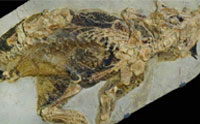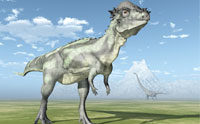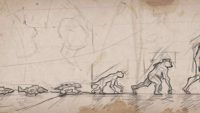Scientists mapped the color shading of a particularly well-preserved Chinese fossil—a Psittacosaurus [sit uh kuh SAWR us]—onto several three-dimensional, lifelike models of the dinosaur. They discovered that the extent of lighter areas on its belly matched that of today’s animals that live in shaded areas, like beneath trees, as opposed to open plains. In the process, the researchers confirmed pigment and protein remnants in the fossil skin that should have decayed long ago if they were really millions of years old. More… …read more Read more here: icr.org
By Ken Ham A news item on a new research study revealed something very startling—alligators are, well, still alligators! Well, maybe this is only startling if you’re an evolutionist! Apparently they’ve “remained virtually untouched by major evolutionary change for at least 8 million years” despite the sea level fluctuations and major climatological changes evolutionists assume happened in the Florida peninsula during that time. The lead author of the research paper says, If we could step back in time 8 million years, you’d basically see the same animal crawling around then as you would see today in the Southeast. Even 30 [More]
The human genome is the most complex computer operating system in the known universe and defies naturalistic explanations. …read more Read more here: creation.com
Fast-forming canyons show that textbook pictures of slow and gradual processes are really just storytelling. …read more Read more here: creation.com
By Dr. Elizabeth Mitchell Discovery of placodes on reptile embryos is being seen as proof of the evolutionary connection between reptilian scales, bird feathers, and mammalian hair. …read more Read more here: AIG Daily
An American research team recently reanalyzed a strange fossil the Works Progress Administration excavated in 1940 from the Triassic Otis Chalk in west Texas. This partial skull showed that the animal had a huge, thick dome on its head, much like pachycephalosaurs found in Cretaceous deposits. According to conventional consensus, 100 million years and a vicious extinction event separate the two fossil types. What role did an evolutionary perspective play in this team’s conclusions about this supposedly out-of-place dome-headed fossil? More… …read more Read more here: icr.org
Do these controversial finds provide a good argument against deep time? …read more Read more here: creation.com
By Ken Ham Antibiotic resistance in bacteria is one of the biggest problems facing modern medicine, and it’s also often lauded as evidence for evolution. Bacteria have the ability to survive when introduced to an antibiotic that would normally kill them. Recently a popular video claimed that scientists were able to watch evolution happen in just 11 days as bacteria “evolved” resistance. But did they really see molecules-to-man evolution in action? Well, we’ve written about antibiotic resistance many times, and this new study offers no new support for evolution. Evolution involves the addition of brand-new genetic information to create novel [More]
By Brooke C. Nelson Did this constellation name and idea originate at the same place and from the same people before being scattered throughout the earth? …read more Read more here: AIG Daily
Discoveries of such things as gene regulatory networks and epigenetics are creating a crisis for evolutionists …read more Read more here: creation.com
By Ken Ham Up until very recently, all giraffes were considered one species with up to nine subspecies. But new research in genetics claims there are four distinct species of giraffe—the southern giraffe, northern giraffe, reticulated giraffe, and Masai giraffe. Apparently these new species are genetically “as distinct as brown bears are from polar bears.” These four giraffe species and the okapi are all members of the giraffe kind that God originally created. God designed each kind with a massive amount of genetic variability in their DNA. This incredible variety allows them to spread out and fill different environments all [More]
By Ken Ham As scientists study God’s creation, they never cease to be surprised by what they find. The newest surprise comes from a well-preserved fossil of a Labrador-sized dinosaur, the Psittacosaurus. Detailed examination of this fossil reveals that this dinosaur “dressed in camouflage.” This dinosaur was buried with skin and even pigments intact. This means it had to be buried extremely rapidly before it had a chance to decay. Of course, the conditions of the global Flood of Noah’s day were perfect for rapidly burying organisms. As the floodwaters washed over the continents, miles of sediment were ripped up [More]
One of Australia’s iconic animals has a big bite but is not as fearsome as it’s made out to be. …read more Read more here: creation.com
These huge creatures are used for evolutionary propaganda, but they can best be explained from a biblical worldview. …read more Read more here: creation.com
By Dr. Andrew Fabich Evolutionists frequently cite the genetic code’s universality as proof of evolution from a common ancestor. …read more Read more here: AIG Daily
By Troy Lacey Researchers made the claim that evolution of the placental mammals sped up faster in the 10 million years following the extinction of the dinosaurs. …read more Read more here: AIG Daily
Data storage technology has come a long way since punch cards. But the undisputed king of data density is still DNA. A team of scientists fit 70 billion copies of their genetics book—including page formatting instructions and images totaling 700 terabytes of data—into just one gram of DNA. Read More: Scientists Store 70 Billion Books on DNA | The Institute for Creation Research
Exciting research from the summer of 2012 described DNA variation in the protein coding regions of the human genome linked to population growth. One of the investigation’s conclusions was that the human genome began to rapidly diversify not more than 5,000 years ago.1,2 This observation closely agrees with a biblical timeline of post-flood human diversification. Yet another study, this one published in the journal Nature, accessed even more extensive data and unintentionally confirmed the recent human history described in Genesis.3 Read More: Genetics Research Confirms Biblical Timeline | The Institute for Creation Research
Perhaps the greatest problem for evolution is where and how the first biomolecules and cells originated by means of random processes. And if that problem wasn’t substantial enough—essentially statistically and biologically impossible—a new discovery makes the odds even worse. Colonies of complex fossil microbes have recently been found that allegedly push the origin of life to at least 3.7 billion years into the past—a period of time thought to be unfavorable for life to begin. More… …read more Read more here: icr.org
By Dr. Gordon Wilson You don’t have to travel to Paris to see one of the world’s greatest cathedrals. If you look carefully, one may be walking around in your own backyard. …read more Read more here: AIG Daily
By Melinda Christian Scientists are learning more and more about the marvelous abilities of animals, which go far beyond physical design. …read more Read more here: AIG Daily
By Dr. Joe Francis To keep us safe, our body coordinates with a vast network of foreign agents that have joined our side. …read more Read more here: AIG Daily
Consider the concept of space as a physical material with a tension and a fourth spatial dimension. …read more Read more here: creation.com
By Dr. Georgia Purdom Truth or science fiction? It’s possible to bypass your ears and send electrical signals directly to the brain. True. …read more Read more here: AIG Daily
Should creationists expect chimpanzees and humans to be genetically similar? And where did Jesus’ Y chromosome come from? …read more Read more here: creation.com
By Dr. Danny R. Faulkner From time to time there are reports of the discovery of a possible earth-like planet. This is the situation of Proxima Centauri b, announced on August 24, 2016. …read more Read more here: AIG Daily
By Jake Hebert Despite its popularity, the Milankovitch hypothesis has many problems that are acknowledged even by secular scientists (Cronin 2010, 130–139). …read more Read more here: AIG Daily













































